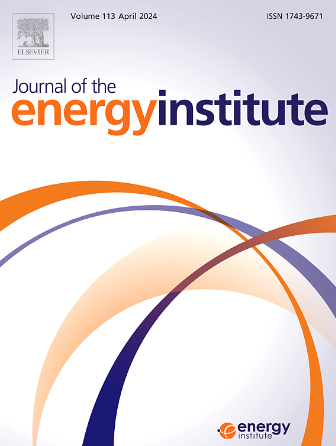Mechanism study on the pyrolysis of lignin in cotton stalks catalyzed by K2CO3 to produce guaiacol: Experiment and DFT simulations
IF 6.2
2区 工程技术
Q2 ENERGY & FUELS
引用次数: 0
Abstract
In this study, the regulation mechanism of K2CO3 catalytic pyrolysis of lignin in cotton stalk for producing guaiacol was explored, and its effects on tar components were studied through the combination of experiments and density functional theory. The results showed that the addition of 7.5 % K2CO3 to cotton stalk significantly altered the composition of tar, and guaiacol content in phenols increased from 2.47 % to 33.11 %. At the same time, the contents of alkanes and esters decreased by 29.21 % and 28.43 %, respectively. The simulation results revealed that K+ changed from a three-dimensional structure to a planar structure by coordinating with the oxygen atoms in the model compound. The structural change significantly weakened the stability of the bond, thereby decreasing the bond dissociation energy of the Cβ-O bond, which preferentially promoted the homolytic cleavage of the Cβ-O bond of the model compound to generate free radical intermediates. These intermediates accelerated the reaction process in the early stage of pyrolysis. In addition, K+ regulated the subsequent free radical reaction pathway by adjusting the energy barrier, mainly inhibiting the homolytic side reaction. The reaction energy barrier increased by approximately 32.19 % and promoted the co-decomposition path. The energy barrier decreased by approximately 11.14 %, thus significantly improving the selective generation of guaiacol.
K2CO3催化棉秆热解木质素制愈创木酚的机理研究:实验与DFT模拟
本研究探讨了K2CO3催化热解棉秆木质素制备愈创木酚的调控机理,并通过实验与密度功能理论相结合,研究了K2CO3催化热解棉秆木质素制备愈创木酚对焦油组分的影响。结果表明,添加7.5%的K2CO3显著改变了棉秆焦油的组成,酚类物质中愈创木酚的含量由2.47%提高到33.11%。同时,烷烃和酯的含量分别下降了29.21%和28.43%。模拟结果表明,K+通过与模型化合物中的氧原子配位,从三维结构转变为平面结构。结构变化明显削弱了键的稳定性,从而降低了Cβ-O键的键解离能,优先促进模型化合物Cβ-O键的均裂裂解生成自由基中间体。这些中间体在热解初期加速了反应过程。此外,K+通过调节能垒调节后续自由基反应途径,主要抑制均溶副反应。反应能垒提高约32.19%,促进了共分解路径。能量势垒降低约11.14%,从而显著提高愈创木酚的选择性生成。
本文章由计算机程序翻译,如有差异,请以英文原文为准。
求助全文
约1分钟内获得全文
求助全文
来源期刊

Journal of The Energy Institute
工程技术-能源与燃料
CiteScore
10.60
自引率
5.30%
发文量
166
审稿时长
16 days
期刊介绍:
The Journal of the Energy Institute provides peer reviewed coverage of original high quality research on energy, engineering and technology.The coverage is broad and the main areas of interest include:
Combustion engineering and associated technologies; process heating; power generation; engines and propulsion; emissions and environmental pollution control; clean coal technologies; carbon abatement technologies
Emissions and environmental pollution control; safety and hazards;
Clean coal technologies; carbon abatement technologies, including carbon capture and storage, CCS;
Petroleum engineering and fuel quality, including storage and transport
Alternative energy sources; biomass utilisation and biomass conversion technologies; energy from waste, incineration and recycling
Energy conversion, energy recovery and energy efficiency; space heating, fuel cells, heat pumps and cooling systems
Energy storage
The journal''s coverage reflects changes in energy technology that result from the transition to more efficient energy production and end use together with reduced carbon emission.
 求助内容:
求助内容: 应助结果提醒方式:
应助结果提醒方式:


